On Saturday the 8th of June the friends of México presented the second of their talks for 2024 at The W.A. Museum in Perth, Western Australia as part of the Boola bardip or “many stories” program. The talk was presented by Eugenia a prominent member of the Perth chapter of FOMEX.

Boola bardip is an indigenous term from the whadjuk (1) noongar (2) people whose traditional lands the museum stands upon.
- there are 14 noongar language groups that inhabit Western Australia ranging geographically from the west coast at a point north of Jurien Bay which extends easterly to a point approximately north of Moora and then roughly south-east to a point on the southern coast between Bremer Bay and Esperance. These groups include Amangu, Ballardong, Yued, Kaneang, Koreng, Mineng, Njakinjaki, Njunga, Pibelmen, Pindjarup, Wadandi, Whadjuk, Wiilman and Wudjar.
- While Noongar is identified as a single language, there are several ways of pronouncing it, which is reflected in the spelling: Noongar, Nyungar, Nyoongar, Nyoongah, Nyungah, Nyugah, Yungar and Noonga.
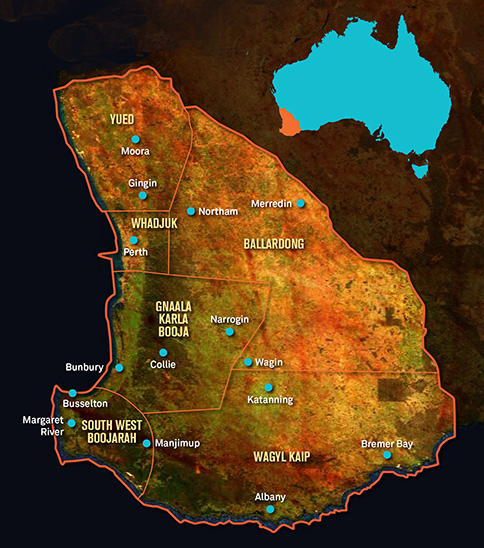
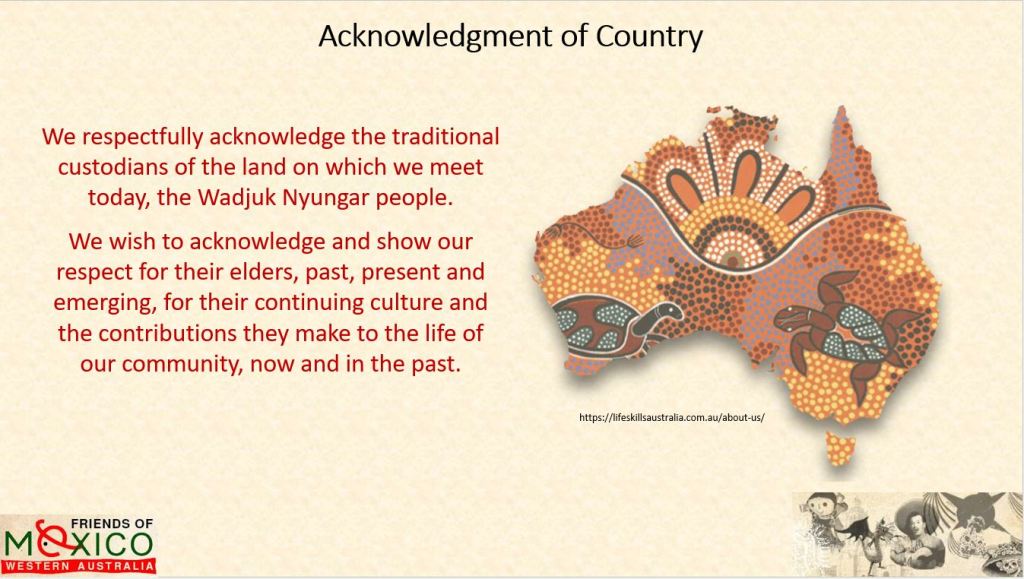

Todays speaker and seminar was introduced by the current president of FOMEX in Perth the perennially young at heart Cesar Ortega.

What follows is a copy of the slides as presented by Eugenia (Gigi) and her notes as she sent them to me. There are also many links to references regarding Gigi’s notes so you can follow up with further research if you so desire (which I highly recommend as the history of México is a rich and compelling one). I have also taken a few liberties (Por favor perdóname Gigi) and added some extra material in a few places for my own interests sake. ***These add ons will be contained within asterisks and in BOLD text*** Click on any of the images to expand them if you’d like a closer look.

The notes only tell part of the story as Gigi adlibbed a lot of material and eloquently expanded upon her notes as the presentation proceeded.

***Codices is the plural of codex, so 1 codex or many codices****

I have to start talking about this beautiful códices or codex (as they are called by modern historians)
- thanks to them we know that before the Spaniards arrived in Mexico there were important Mexican Women ruling towns and cities in Mexico.
A codex is an ancient handwritten book made out of bark paper and folded like an accordion.
The Aztec codices show us the life and culture of the ancient civilizations that Mexico had before and after contact with Europeans.

This is the tree from which the indigenous people of Mexico took the bark to make paper or Amatl as they call it (now called amate). They also used deerskins sewn together.
**Below I have added a little more on amate paper as I find the process fascinating. The bark is soaked until pliable. It is then woven into sheets which are pounded and polished with stones to create a durable paper. The photos below are by Heather Matthews at https://paperconnection.com/amatetraditional-mexcian-bark-cloth/**


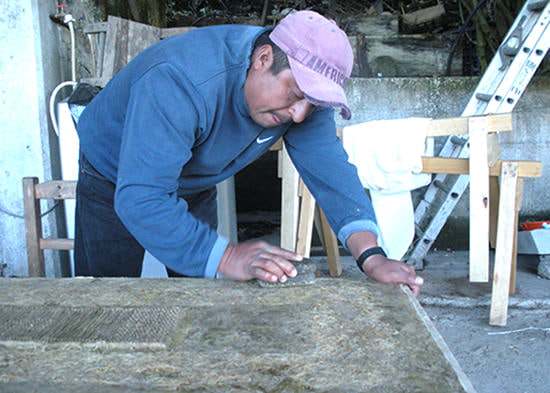
According to Bernal Díaz del Castillo,
-A Spanish conquistador who participated in the conquest of the Aztec Empire under Hernán Cortés
-he wrote a book called: True Story of the Conquest of New Spain.
-He said Moctezuma had a library full of books, known as amatl, or amoxtli,.

Pre-Hispanic codex
Pre-Hispanic codices were written before the conquest.
There are only 16 left. The Spaniards burned them.
***Although there are very few of these codices in existence in March of 2024 a family from México who held the function of “traditional stewards of the cultural legacy of Culhuacan and Iztapalapa” delivered three codices to the Mexican Government. These documents (see image below), the Map of the Founding of Tetepilco (a), the Inventory of the Church of San Andrés Tetepilco (b), and the Tira of San Andrés Tetepilco (c), are a fascinating discovery for scholars as they add previously unknown knowledge regarding the history of Tenochtitlan*****

Colonial codices

There are around 500 codices that were made after the Spanish conquered the Aztecs in 1521.
How this codex survived
-The Spanish priests, who were converting the indigenous communities to Catholicism, wanted to understand indigenous cultures in order to make religious education easier.
-they asked people to write their histories and customs.
-native leaders needed to show proof of their lands and ancestry to claim them from the colonial authorities.
-This led to many maps and family trees being produced.
– the Spaniards came to accept and rely on them as valid and potentially important records.

Some codices were produced to show the bad treatment that indigenous communities experienced at the hands of Spanish enconmenderos (landowners who received tribute from indigenous communities in exchange for conversion to Catholicism and instruction in Spanish). This is a page from the Codex Kingsborough,
-it shows a legal dispute between the Indians of Tepelaoztoc and Don Velazquez de Salazar.
-Here, they are being burned alive for not delivering tribute on time!
Many of these codices are in France or England. At some point the codex came into the possession of the antiquarian and scholar of Mesoamerica Edward King, Viscount Kingsborough, that is why its named after him. After his death in 1837, it was bought by a bookseller named Rodd in 1843, and later bought from him by the British Museum.[1]

Women became rulers when there was not an available male to inherit the throne. There are some sources that maintain that there were woman ruling different Mesoamerican peoples but as they were women they were not included in their history.
The Tira de Tepechpan is a sixteenth-century calendar.
– It illustrates events occurring in a town called Tepechpan, Hidalgo and Mexico-Tenochtitlan which was the capital of the Aztec Empire.
The Aztecs were the most powerful civilisation when the Spaniards arrive. Tenochtitlan nowadays is the historic centre of Mexico City.
-This strip is held at the National Library in Paris
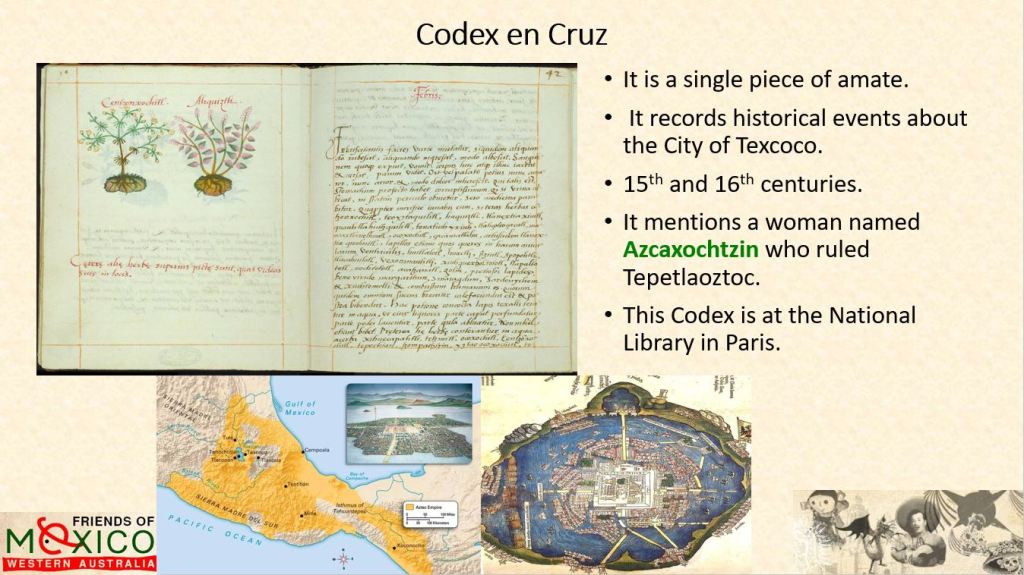
Codex en Cruz
- It is made of amatl paper. It records historical events: the succession of rulers, wars and famines from the 15th and 16th centuries.
- The codex centres on the city of Texcoco but also contains information of Tenochtitlan, Tepetlaoztoc and Chiautla (arriba de texcoco).
- It is held at the National Library in Paris.
This codex mentions a woman named Azcaxochtzin who ruled Tepetlaoztoc
Tlapalizquixochtzin Queen of Ecatepec


La Malinche:
• Interpreter for Hernán Cortés during the Spanish Conquest of the Aztec Empire (1519-1521).
• Hernán Cortés led the expedition that caused the fall of the Aztec Empire.
****the legend of Malintzin/Malinche is an important one in the history of Mexico – possibly more than any other womans (except La Virgen) – one story goes is that she was of noble birth but was sold into slavery after the death of her father (so as not to cause problems with her mothers new husband). As a noble born child she was well educated (and had a cunning intellect) she picked up languages quickly. When Cortés was making his way inland to Tenochtitlan she was amongst a group of women “gifted” to him by the lord of a land they were passing through. At this stage Cortés had a man in his group (Aguilar) who could speak Mayan and was able to translate this language into Spanish for Cortés but when they met a group sent from Tenochtitlan on behalf of Moctezuma (sent with the purpose of discouraging him from proceeding farther inland) they spoke in a language (Nahuatl) that Aguilar could not understand. The story goes that it was at this point that Malintzin pointed at Cortés (the question said to have been asked was “Who is in charge of this group?”) at which point Cortés realised the value of Malintzin. She interpreted Nahuatl into Mayan and Aguilar translated Mayan into Spanish for Cortés. Malintzin however very quickly learned the Spanish language at which point Aguilars services were no longer needed. From that point onward she was indispensable to Cortés****
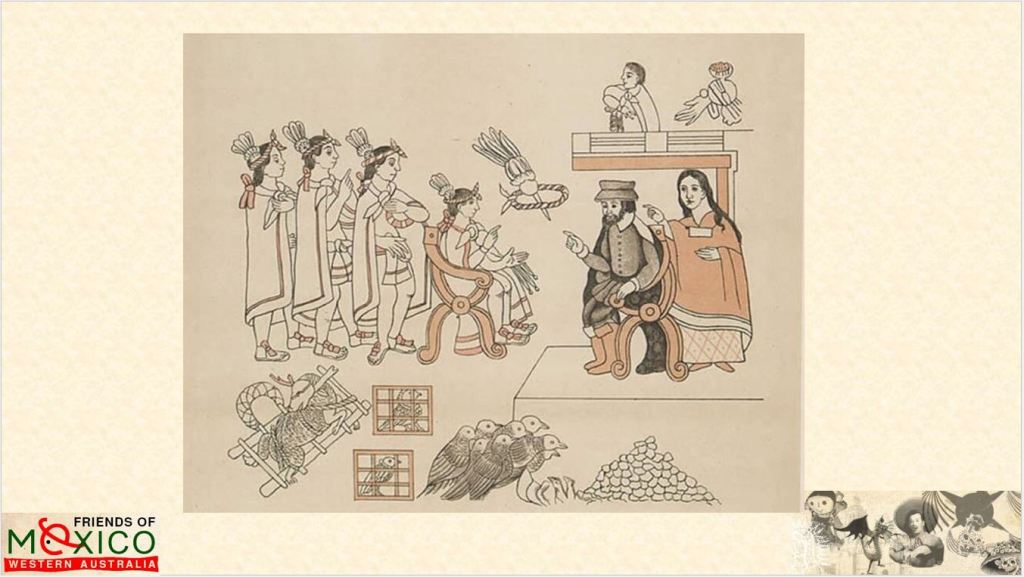
-She was respected by native tribes because she helped the indigenous people to communicate with the Spaniards.
-Sadly La Malinche became an ally of the Spaniards saving Cortes and his men from the Aztec attacks.
-She became very close friend to an old woman who told her about a plot organised by the Aztec King Moctezuma II
-La Malinche had a great ability understanding politics, religion and war between the tribes of the region and with her great help at the end Cortés was able to overthrow the Aztec Empire.

Our Lady of Guadalupe.
Interestingly she is probably the most prominent Mexican woman from the past and the present in Mexico.
-The shrine of the Virgin of Guadalupe is the most visited Catholic pilgrimage destination in the world.
- In December 2023 there was a record number of 11 million pilgrims visiting the Basilica of Guadalupe in Mexico City to commemorate the anniversary of the apparition (493 years). In 2031 it will be the 500 anniversary of her apparitions. In 3 days 10th -12th of December
The story tells that in 1531 the Virgin Mary appeared 4 times to Juan Diego, a Chichimec peasant and she spoke to him in Náhuatl.
-she asked him to build a church in the Hill of Tepeyac where she appeared.
-Flowers in his cloak = cape – archbishop
***the story goes that la Virgen (some say it was an incarnation of the goddess Tonantzin) instructed Juan Diego to tell the Archbishop that he needed to build a place of worship (church) on the hill but that Juan knew the Archbishop would not listen to a lowly peasant such as himself but he persisted. After 3 attempts at speaking with the Archbishop La Virgen told Juan Diego to return to the hill and collect the flowers that grew there and to show them to the Archbishop as proof of her visitations. Juan was confused as the hill was barren and nothing grew there but when he returned he was surprised to see beautiful flowers which were unknown to him. He collected them in his tilma and carried them to the Archbishop. When Juan Diego dropped the edges of his tilma to release the flowers the Archbishop was surprised to see roses, a flower as yet unknown to the Americas, and imprinted on Juans tilma was an image of La Virgen. This convinced him to build the church***

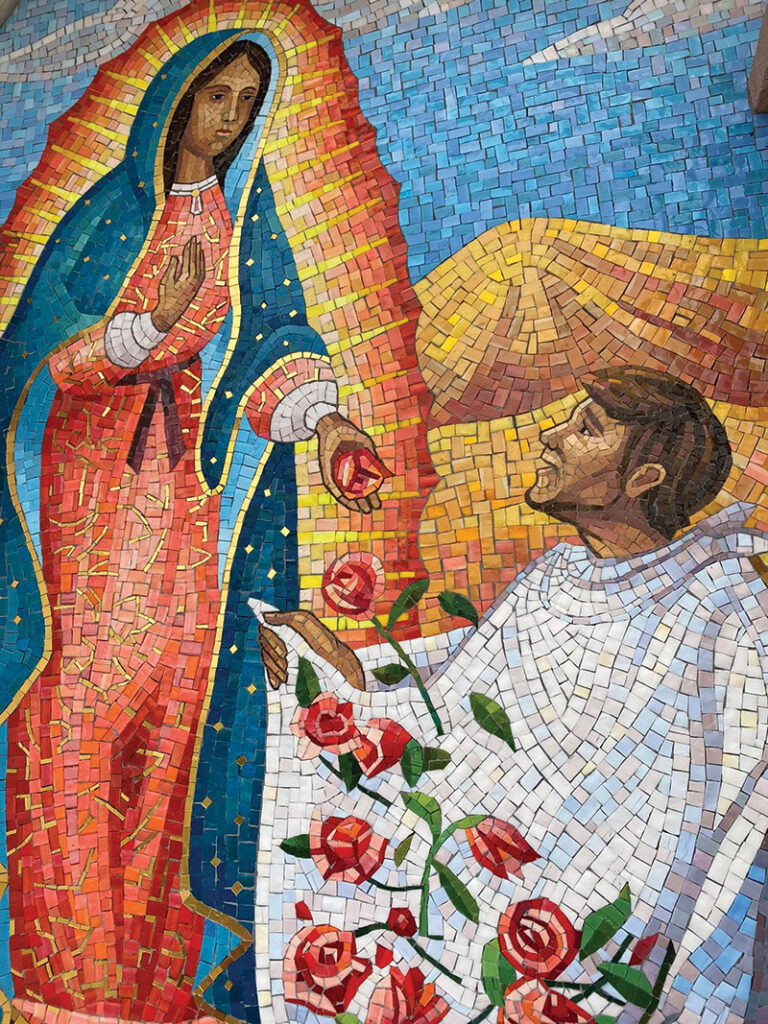
The Virgin of Guadalupe is considered the Patroness of Mexico and the Continental Americas; she is also venerated by Native Americans, there are many churches around the world were here image is so people can pray to her.

Juana Inés de Asbaje y Ramírez de Santillana, better known as Sor Juana Inés de la Cruz[a] she is presently considered one of the most important female authors in Spanish language literature and the literature of Mexico.
-Later described as child prodigy,
-was fluent in both Latin and Nahuatl,
-learned philosophy, and mathematics. She was given free access to her grandfather’s private library.[7]
In 1664, at the age of 16, Inés was sent to live in Mexico City.
- She asked her mother’s permission to disguise herself as a male student so that she could enter the university
– she received several proposals of marriage, which she declined.[8]
– in 1667 she decided to become a nun Up to this day she has been a figure of great controversy. She been presented as a symbol of Mexican nationalism, freedom of speech, she has represented women’s rights, and sexual diversity, even a candidate for Catholic sainthood.

| Leona Vicario (April 10, 1789 – August 21, 1842), She was one of the most important figures of the Mexican War of Independence. She was a member of Los Guadalupes: secret political society who wanted obtain the independence of Mexico from Spain. -She financed the rebellion with her large fortune. -She served as a messenger, helped fugitives, sent money and medicine, and helped in all she could. Because of her strong feminist beliefs, she took many risks and sacrificed much wealth in the name of liberation. |

Doña Josefa Ortiz de Domínguez or La Corregidora (8 September 1768 – 2 March 1829[2])
She married the Corregidor = it is an administrative job position were he had to ensure that all the people were under control and that they did not opposed to the elites [elits]. That job position was appointed by the Spanish Empire In 1910, Ortiz de Domínguez [17] and Leona Vicario[18] were the first women to be depicted on Mexican stamps and the second women to be depicted on stamps in Latin America. Her profile also appeared on the five-centavo coin from 1942 to 1976,[19] and on a version of the five-peso coin issued in 2010 as part of a series to commemorate the bicentenary of the country’s independence.[20]
***I’ve added some images of these stamps and coins below)***

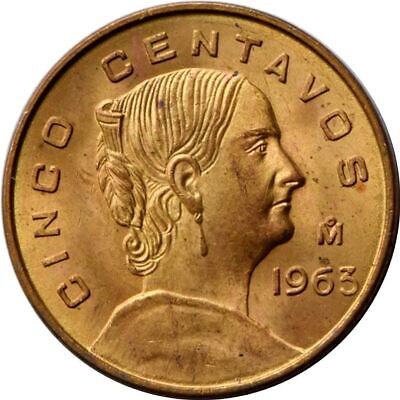
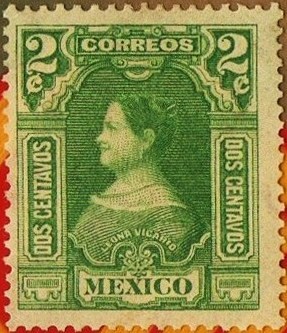


Mexico had a revolution from 1910 to 1920.
-The people of Mexico wanted a change as the Presiden Porfirio Díaz had been in power for more than 30 years.
-He was in favour of the wealthy landowners and industrialist and the rest of the people were struggling to live.
-Soldaderas came from various social backgrounds, from low, rural, mestizo and native women, middle and prominent classes that got involved in the political movement that led to the revolution.
Some revolutionary women achieved the officer status of Coronelas or Generalas commanding a few men.
Some women took male identities dressing as men and being called by the male version. Angela Jimenez became Angel Jimenez, Amelia Robles became Amelio Robles…
the Soldadera or Adelita, Mexican women who supported the male soldiers
-participating in combat,
-help organising the Revolution.
In the years since the Revolution, popular culture adopted the Soldaderas as symbols of , Mexican pride, patriotism, feminism, and culture.
The ideas of these women during the revolution gave rise to a post-revolutionary feminist movement, with international implications, that succeeded in achieving women’s suffrage [sofrege].

In 1941, during the Second World War, Mexico’s President Lázaro Cardenas opened the Mexican borders to welcome a number of European refugees.
It is estimated that Mexico accepted more than fifteen thousand refugees.
Among those people were these 3 important artists:
Leonora Carrington (painter) Lancashire [Lankashir] England
Remedios Varo (painter) (Town in Girona, Spain)
Kati Horna (photographer) Budapest (when it was the Austrian-Hungarian Empire).
They became known as “the three witches”. They invented surrealistic potions and recipes and influenced each other’s work
They found a sanctuary in Mexico. Even though they were not born in Mexico they became Mexican Citizens and lived there for the rest of their lives. And their art was influenced by Mexico’s way of life, folkloric art and mysticism and of course their art was influenced by Surrealism too.
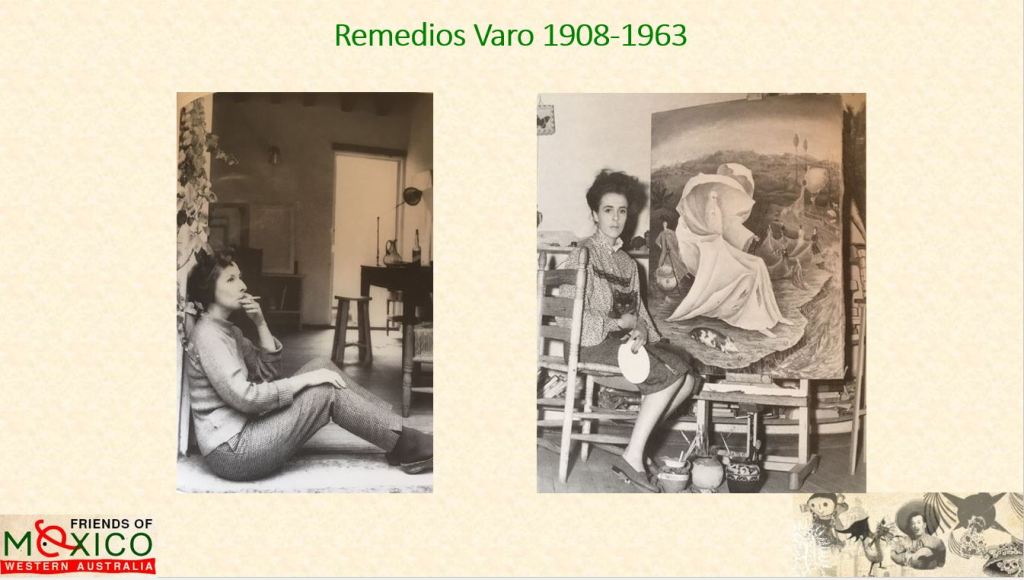
Remedios Varo. She was born in a small town in the province of Girona in Spain. (1908- 1963) 55 year old
– she arrived in Mexico 1n 1941 (33) escaping the Spanish Civil War
– went to a convent school who made her reject religion and preferred the liberal ideas taught by her father.
– In 1924, aged 15, Escuela de Bellas Artes (Fine arts) in Madrid. Many renowned artists like Salvador Dalí attended this school but he was expelled for insubordination. Varo was awarded her diploma as a drawing teacher in 1930.
Her first jobs in Mexico were:
Hand painting furniture
she design costumes for a Ballet for Leon Massine
she enjoyed designing clothes for surrealist costume parties

her main source of income at the end of the 1940’s was illustrating promotional literature for Bayer pharmaceutical.
-Insomnia 1947
-Lumbago and Sciatica 1947
-Rheumatic pain 1948

Remedios Varo Paintings.
- The call (1961)
- The encounter (1951)
- Woman leaving the psychoanalyst (1960) [saicoanalist]

- Alchemy or the useless science (1958)
- Still life reviving (1963)
- Dead leaves (1956) Les feuilles mortes


Kati Horna (1912- 2000) 88 years
She was born in Budapest.
She was a photojournalist, surrealist photographer and educator.
She was one of the few women that photographed the frontlines of the Spanish Civil War but sadly most of her work was lost during the Spanish Civil War.
In 1939 (27 years) she went into exile in Mexico. Mexico became for her a “motherland”, and she confessed her patriotism only for this country.
In Mexico
-she participated in the Campagin for Mexican President Manuel Avila Camacho in 1940.
-She taught from 1958-1963 at the school of Design at the Iberoamerican University and when whe was 61 whe began teaching photography at the San Carlos Academy
-The Academy of San Carlos is in Mexico City. It was the first major art academy and the first art museum in the Americas. It was founded in 1781 as the School of Engraving The Academy of San Carlos was integrated with the National Autonomous University of Mexico, eventually becoming the Faculty of Arts and Design, which is based in Xochimilco.
Kati Horna died in October 2000. Her work has been included in numerous exhibitions in Mexico, Spain, and other countries.

Photographs by Kati Horna

Photographs by Kati Horna

Photographs by Kati Horna
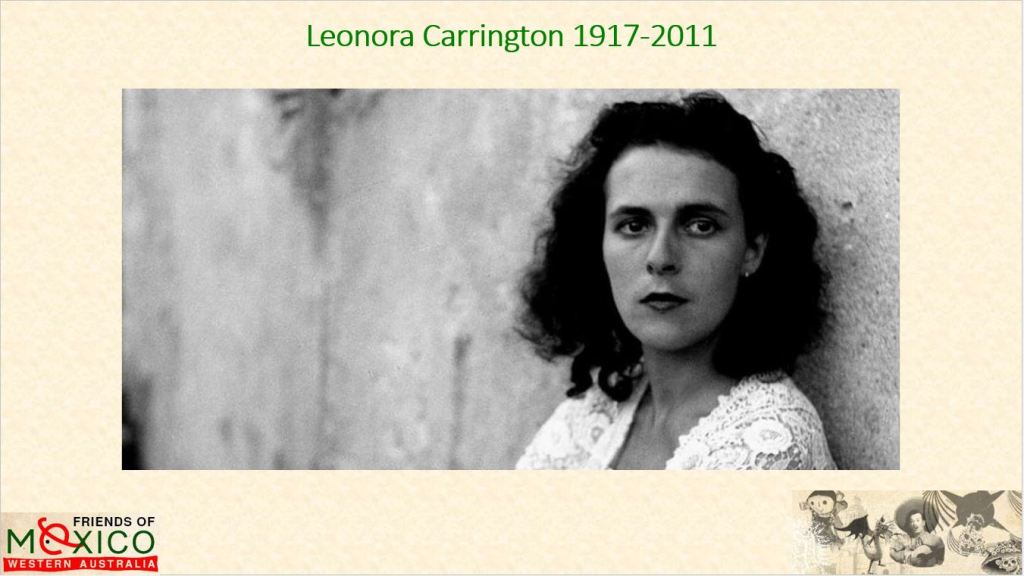
Leonora Carrington (1917- 2022) 94 years
She arrived in Mexico when she was 25
She lived most of her adult life in Mexico City and was one of the last surviving participants in the surrealist movement of the 1930s.[3]
-Carrington was also a founding member of the women’s liberation movement in Mexico during the 1970s.[4][5]
Carrington demonstrated that women should be seen as artists in their own right and not to be used as muses by male artists.[59][60]


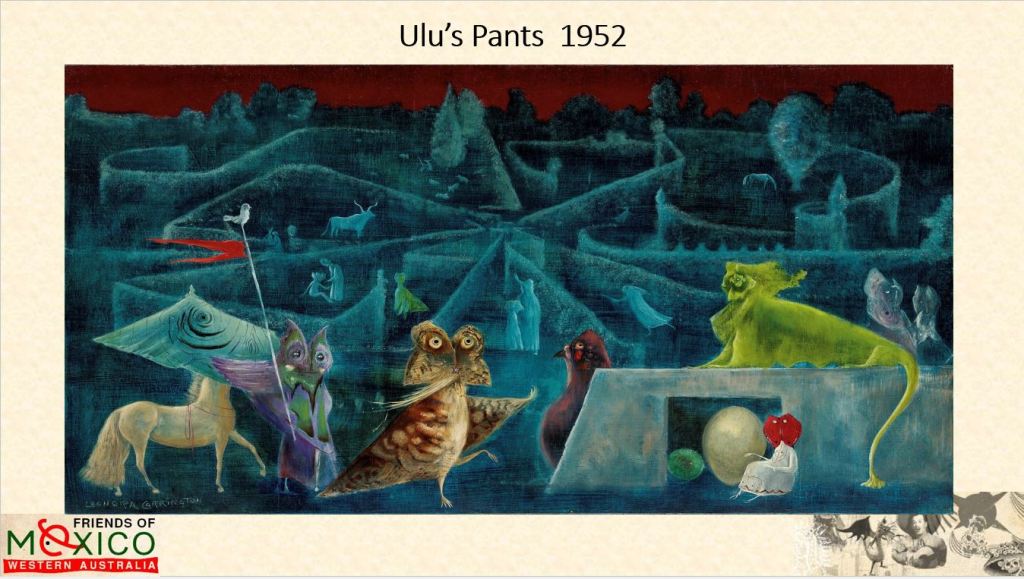
(Gigi lamented the fact that she could not find Ulu’s pants anywhere in the image)
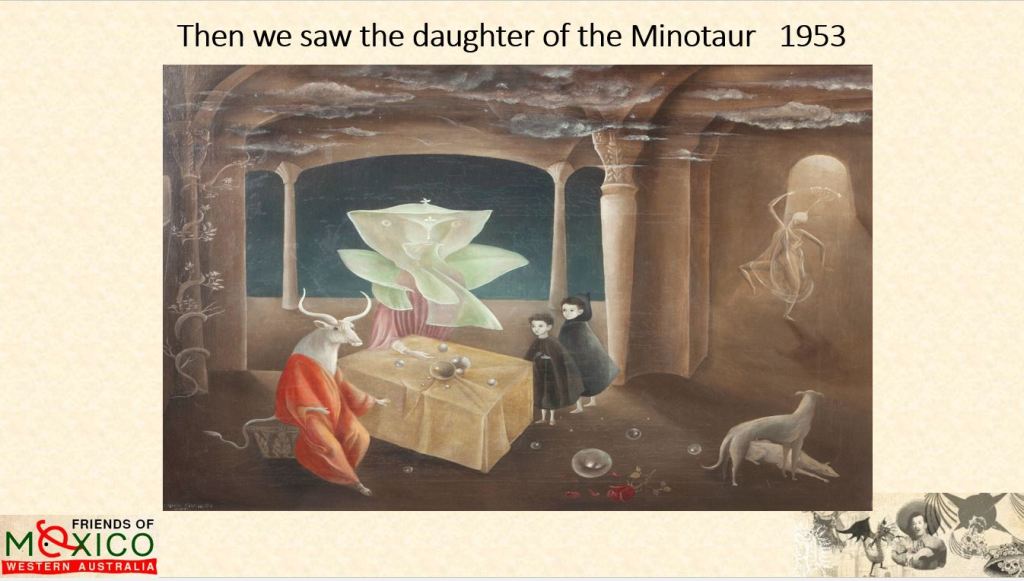
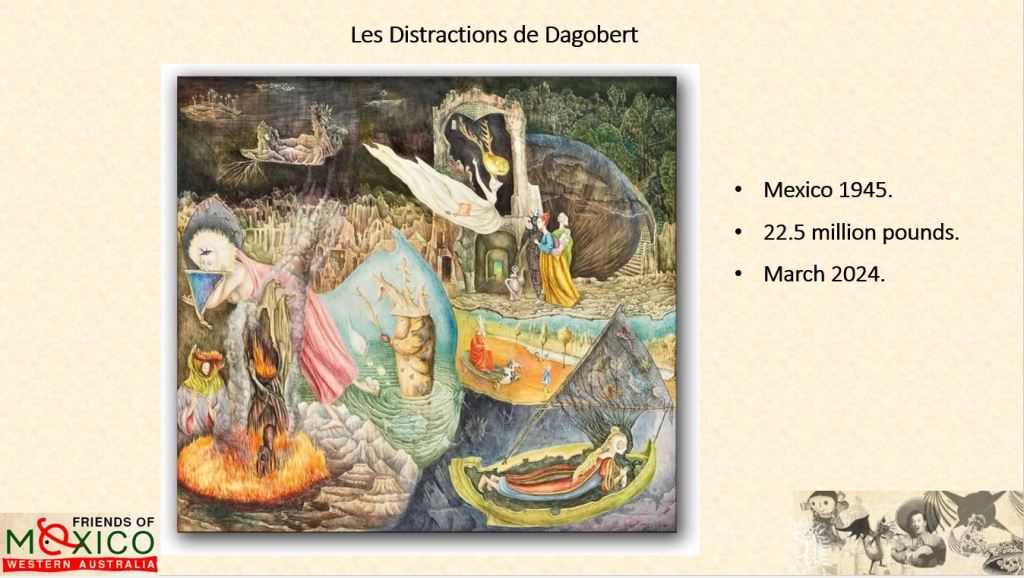
The Distractions de Dagobert.
This painting: Les Distraction de Dagobert was sold in March 2024 for 22.5 million pounds.
It was sold in NY in an auction [ocshon] in only 10 minutes to Argentinian businessman Eduardo Constantini. The founder of the Museum of Latin American Art of Buenos Aires.
It was painted in Mexico in 1945. It has been said that this surrealist achievement could only have been possible in the 1940’s in Mexico.

| María Felix (1914- 2002) 88 years was a Mexican actress and singer. -she was one of the most successful figures of Latin American cinema in the 1940s and 1950s. and one of the best and most beautiful actresses of the golden age of Mexican cinema She was a feminist woman ahead of her time she used to give advise to women by telling them: – Take control of your life. – Women had to be strong, firm and autonomous, always had to have an independent life, even when they were being mothers or wives. – Knowledge is power and it gives us the tools to take control of our lives so we can achieve what we are looking for. – Don’t be afraid to say what you think even if it ruffles feathers (causes controversy or offends people). – Do not settle easily. Men should never be more powerful than women. Men and women have to have the same rights. Her acting career consists of 47 films made in Mexico, Spain, France, Italy and Argentina. In fashion, Félix was dressed by designers like Christian Dior, Givenchy, Yves Saint Laurent, Chanel, and Balenciaga She married 4 times and also had an affair with Diego Rivera. Her second husband was Agustín Lara. 1897–1970 He is recognized as one of the most popular songwriters of his era. In 1956 she marries her 4th husband a French banker called Alexander Berger and spent18 years between México and Paris |
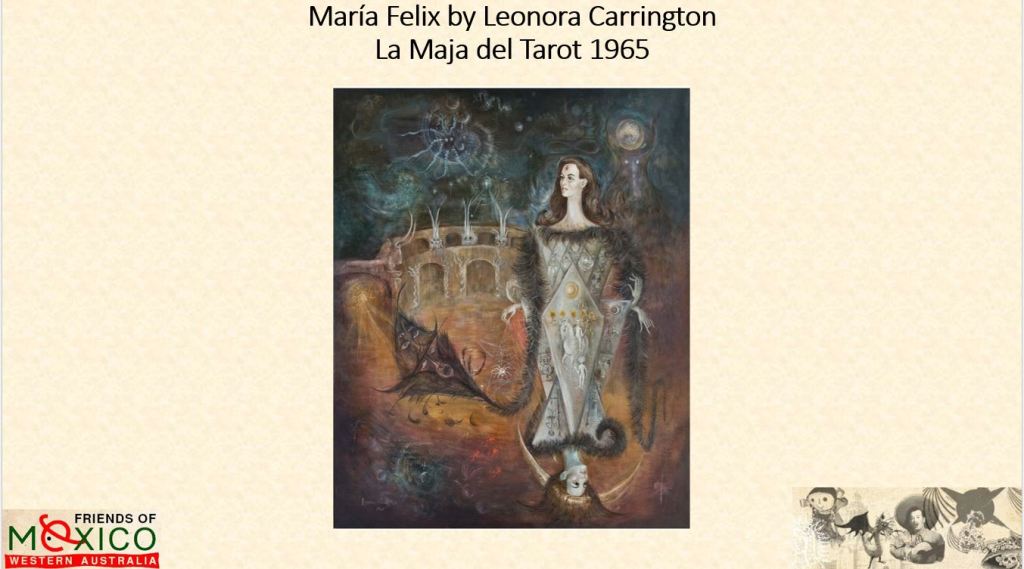

| Monarch Butterfly (husband Kenneth Brugger) He was 53 and she was 21, and she shared his love of nature. Together they began spending their weekends roaming the Sierra Madres looking for the butterflies. Catalina Aguado January, 2 1975 she and her husband discovered the exact place where the Monarch Butterflies spend every winter traveling from Canada and the United States. 241 miles from Mexico in the Sierra Madre Mountains in Michoacan México were the Oyamel fir trees are. |

| Dr Evangelina Villegas Quality Protein Maize. |

L’Oreal- UNESCO Award for women in Science
-It is a Prize awarded to women recognizing their outstanding work as researchers in science.
It is a partnership between the French company L’Oreal and the United Nations Educational Scientific and Cultural Organizanion. -the prize grants $100,000USD each year since 1998
The 2024 Mexican Presidential Elections

Last Sunday June 2nd Mexico had elections for:
- -President who will be in power 2025-2030
- -Senators,
- -Members of parliament (diputados) and the presidency last Sunday June 2nd
- – Governors
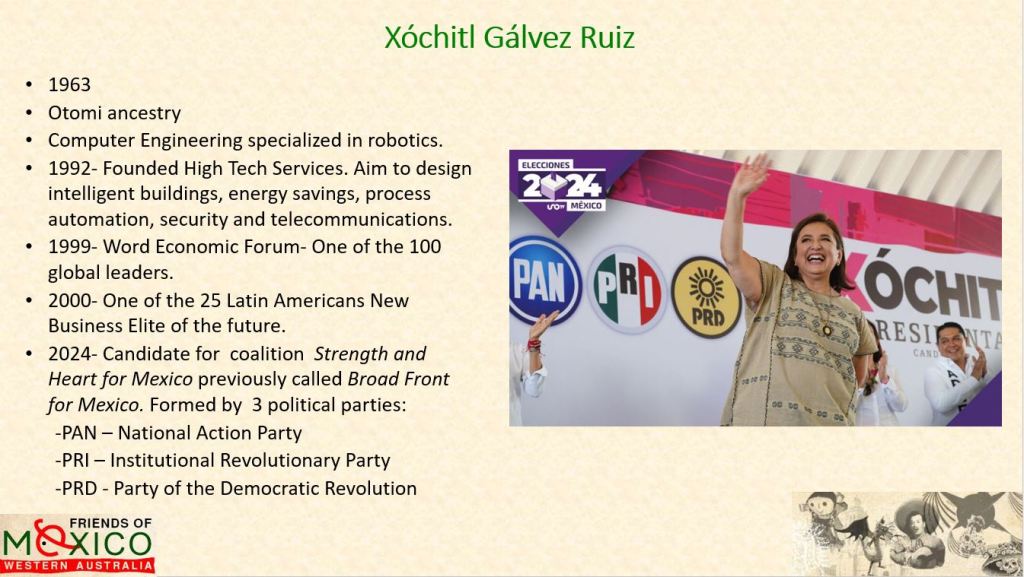
Xóchitl Gálvez Ruiz (1963)
Bertha Xóchitl Gálvez Ruiz is a Mexican politician and businesswoman.
Otomy Ancestry :Guanajuato, Michoacán, Hidalgo, Tlaxcala,- Querétaro
As a politician:
- -was mayor of Mexico City’s Miguel Hidalgo borough. From 2015 until 2018,
– she was head of the National Institute of Indigenous Peoples during the administration of Vicente Fox.[7] From 2000 to 2006,
– she was a plurinominal senator in the Mexican Congress’s LXIV and LXV LegislaturesFrom 2018 to 2023,.
– She was the coalition’s nominee for the 2024 Mexican presidential election.[2]
“This government has normalized violence and wants us to get used to barbarism,”
– during her campaign she promised to confront drug cartels and improve the economy.
“This is not the time for men,” she said in an interview. She assured that if she had come to power, she will combat femicides and the violence against women.
She won the Sé Líder Foundation award, the Zazil award in the social and humanitarian area, the recognition of “Commitment to Others” granted by the Mexican Center for Philanthropy and the “Pericles Medal”, awarded by the Museo Amparo of Puebla for social merit.[5]
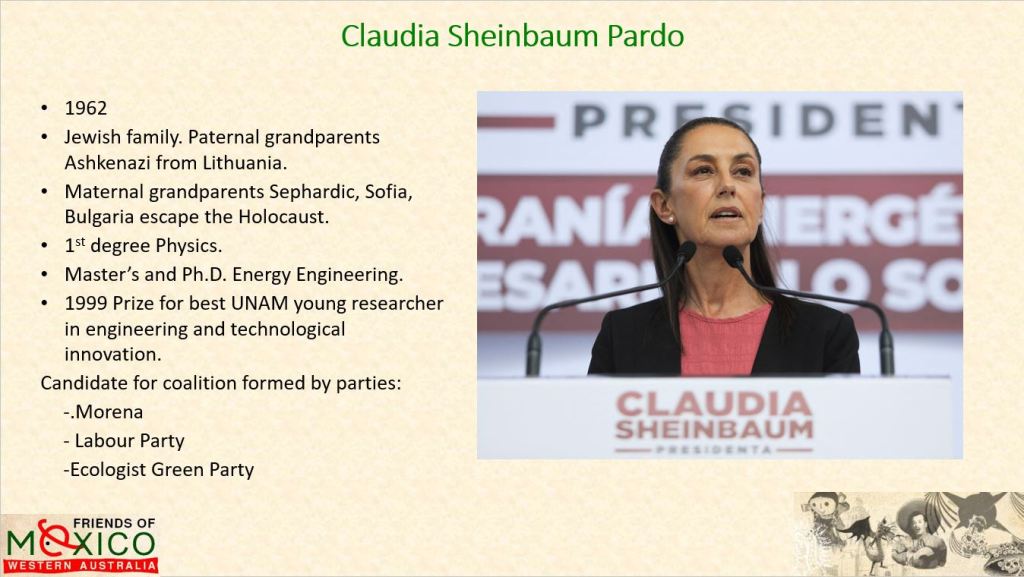
| Claudia Sheinbaum Pardo (born 24 June 1962)[2] is a Mexican politician, scientist, and academic. She is a member of the left-wing political party Morena. -From 2000 to 2006, Sheinbaum served as Secretary of the Environment under future president Andrés Manuel López Obrador during his tenure as Head of Government. -She was elected Head of Government in the 2018 election, where she ran a campaign that emphasized curbing crime and enforcing zoning laws.[4] On 12 June 2023, Sheinbaum resigned from her position as Head of Government of Mexico City to seek Morena‘s presidential nomination in the 2024 election. On 2 June 2024, she won the general election in a landslide. After she assumes office, she will be the first female president of Mexico and the first president of Mexico from a Jewish background. In 2007, she joined the Intergovernmental Panel on Climate Change (IPCC) at the United Nations in the field of energy and industry, as a contributing writer on the topic “Mitigation of Climate Change” for the IPCC Fourth Assessment Report.[20] The group won the Nobel Peace Prize that year. In 1986, Sheinbaum met Carlos Imaz [es], who later became a prominent political figure in the PRD, during his tenure at Stanford University. In 2016, she began dating Jesús María Tarriba Unger, a financial risk analyst for the Bank of Mexico, whom she had known at university.[90] In November 2023, Sheinbaum announced her marriage to Tarriba via social media.[90] She says: I am not a copy of Mexico but we are going to defend the same principles |

Mexico Presidential Election Results
***Claudia Sheinbaum won the election by a landslide. This is a huge event in the history of México***
Ixtzul. The dancing centipede.
The seminar concluded with some dances from the Northern State of Nuevo León performed by Perth’s own Mexican Folkloric Dance Troupe, Ixtzul lead by their maestro Ernesto. These dances were based on European Polka dances.
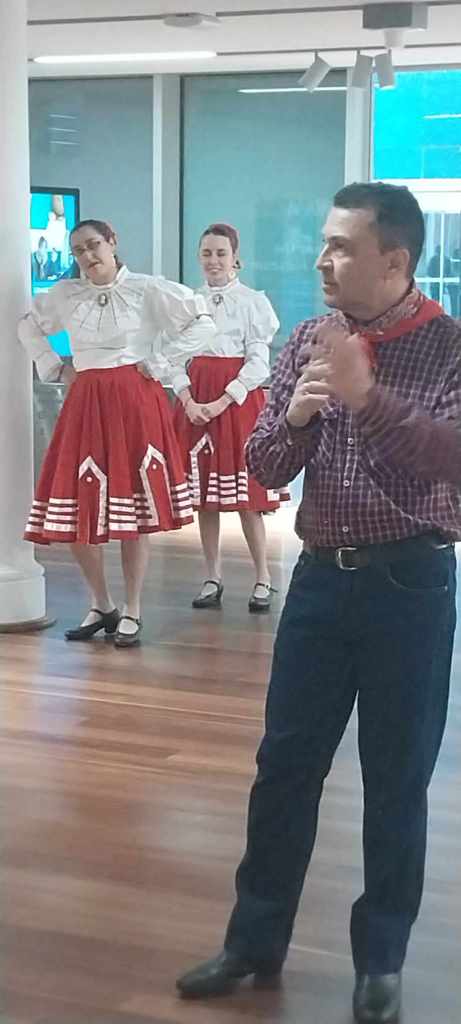
Ernesto’s dance troupe takes its name from sacred book of the Maya, the “Popol-Vuh” from a story of the Maya hero twins Hunahpú and Ixbalanqué (just in case you’re interested)


Here’s a link to Ixtzul performing the dance La Naranja.
https://www.facebook.com/IxtzulDancePerth/videos/1435028604564068

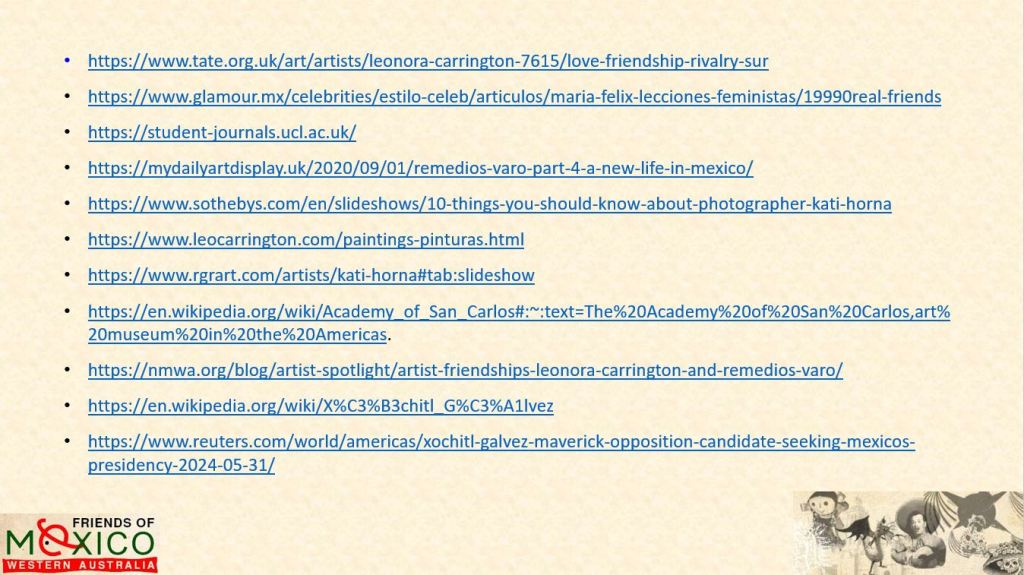

FOMEX’s next talk will be held at the WA Museum on Saturday 10th of August. We hope to see you there.


